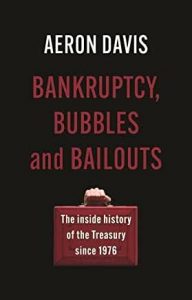[ad_1]
Former prime minister (briefly) Liz Truss may not have been the most important financial mind, however was she proper to argue that there’s equivalent to factor as ‘the Treasury View’ and additional that it hasn’t served the nation nicely? Many individuals throughout the political spectrum would agree. I briefly labored within the Treasury a few years in the past and was definitely shortly socialized into sure rule-of-thumb beliefs – free commerce is sweet, hypothecating taxes is unhealthy, and many others. I’ve some ideas about how you can check the Treasury View speculation, significantly the declare concerning the short-termism it imposes on financial coverage. In the meantime I’ve been studying a couple of books. One was Sam Beer’s previous overview of how the Treasury operated within the Nineteen Fifties. One other is a brand new guide, Bankruptcy, Bubbles and Bailouts: the inside history of the Treasury since 1976, by Aeron Davis.
It was each an attention-grabbing and an extremely irritating learn. The guide attracts on a collection of over 50 interviews which included some completely key insiders – ministers and officers – and some skilled exterior commentators. It could be arduous to attract up a greater record. Nevertheless, the writer has his personal sturdy views and doesn’t distinguish clearly between his commentary and his interviewees’ views. Certainly, a few of his commentary on interviewees I do know strikes me as simply improper, failing to tell apart between their actions as principled civil servants serving the federal government of the day and their private views about privatization or deregulation. I discovered myself wishing I may simply learn the interview transcripts as a substitute.
It isn’t that there aren’t any good authorial observations; quite the opposite, he factors out the inconsistency of globalising and deregulating the monetary markets similtaneously making an attempt to regulate the expansion of the cash provide (that was occurring in my period); or that the hit to manufacturing from alternate charge appreciation within the early 80s coincided with deliberate coverage actions that harmed business and helped finance. Certainly, the principle theme of the guide is the financialization of the financial system – though it appears to me this had as a lot to do with political selections as Treasury dogma. There’s a significantly attention-grabbing chapter concerning the monetary disaster and the reorganisation of monetary supervision.
Nevertheless, former Perm Sec Nick Macpherson is one believer within the thought of a Treasury view, setting out its key components in a speech he gave in 2014, all centred across the asserted limits to what authorities can accomplish in financial coverage. I feel there’s nonetheless one thing to pursue in documenting not a lot what it’s as why it’s, and the way it lasts regardless of the large modifications within the financial system and fast turnover in personnel, and what the implications are for higher financial administration. The book is nicely price studying however it’s a view by way of a selected lens.
[ad_2]


